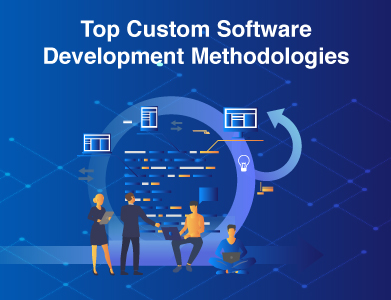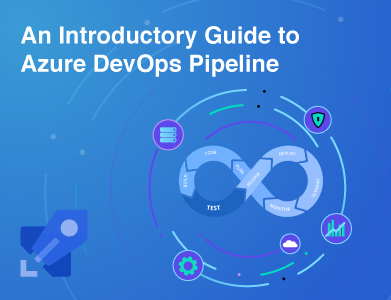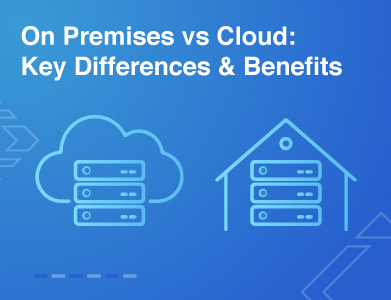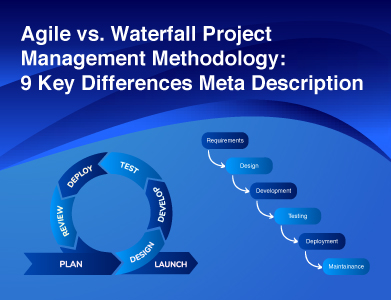What is Cloud Native Application Development?
 Admin
Admin Cloud
Cloud Apr 04, 2024
Apr 04, 2024
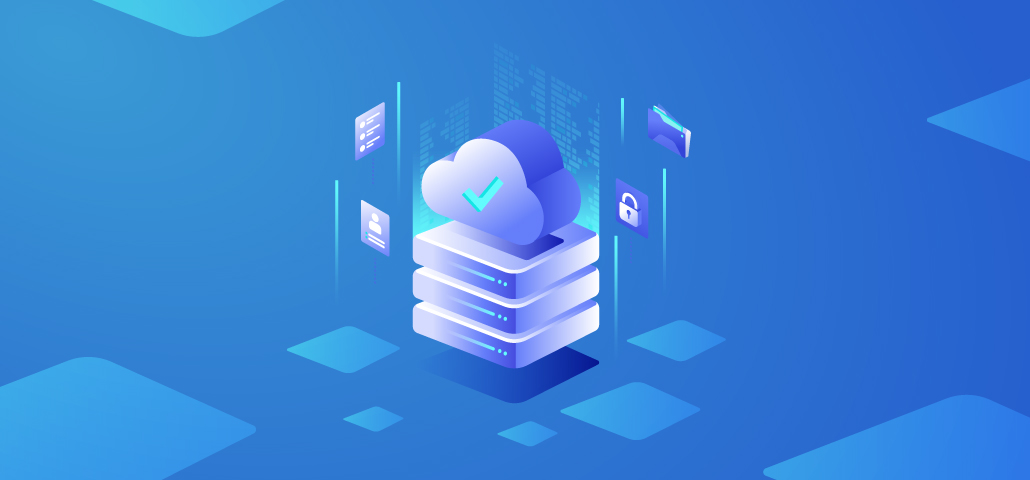
Table of Content
Cloud-native development allows us to develop complex software applications quickly and efficiently. It also allows us to leverage the benefits of the latest technologies, such as AI, IoT, and robotic process automation.
This approach ensures seamless integration between different services, allowing users and customers a memorable experience. Cloud-native applications are designed specifically for the cloud, integrating the benefits of cloud computing, microservices, and containers.
In this blog, you will learn about Cloud Native application development and how they can help your business.
What is Cloud Native Application
Cloud-native is an approach for developing software applications as microservices and running them in containers on platforms that leverage the cloud computing model.
Imagine you are having a sale on your e-commerce platform. And suddenly, high traffic on your website leads to the need to scale the payment processing services. However, if your application is built with a traditional monolithic architecture, you must scale the entire application. As all components are tightly integrated.
This will be resource-intensive and time-consuming. What if you could scale the payment processing microservice only.?
This can be done if your application uses a Cloud Native microservices architecture. Unlike the traditional monolithic approach, Cloud Native Development Services breaks down application functionalities into smaller microservices.
This application is built and can run in any type of cloud ( public, private, or hybrid). Cloud-native application development is not adapted to run in the cloud but is built from the ground to take advantage of the cloud's flexible nature. This means you can quickly scale, modify, or update your application with minimum hassle.
Components of Cloud Native Application Development
Cloud Native application development includes collections of small, loosely coupled services(microservices) packaged into containers. These containers are orchestrated across cloud infrastructure for efficient resource utilization.
Let's understand each component and its use case in Cloud Native application development.
1. Microservices
Microservices are a series of interdependent services of an application. Every microservices has its own data and supports a specific business operation.
They communicate with one another via application programming interfaces (APIs). As they have their own codebase, they can be updated individually without affecting other services in cloud native application development.
Read More: Microservices Best Practices
2. Containers
As the name suggests, containers store microservices with their dependencies (such as resource files, libraries and scripts needed to run main application) in cloud native systems. This allows Cloud Native application development to run independently from the host operating system and hardware.
Thus, in Cloud Native development services, each component is built as a separate microservice and packaged into its container. Now, instead of managing all these containers individually, you can use a container management/orchestration system like Kubernetes or Amazon ECS. This system acts as a central control plane that manages and coordinates all the containers across multiple cloud servers or nodes.
3. APIs
Remember when you bought that t-shirt from Amazon and were offered the option to pay through PayPal or Gpay? Have you ever wondered how the payment processing system got the billing and payment information?
It is made via APIs, which are a way through which different applications or software communicate. In cloud-native application development, APIs enable the communication between loosely coupled microservices, bringing them together. Microservices inform you what data they need through APIS and produce the result using the same.
4. Service mesh
Service mesh is an infrastructure layer that manages communication between various microservices. They help software developers add additional features without writing new code for Cloud Native applications.
A service differs from an API in that an API is responsible for cloud-to-server communication, whereas a service mesh manages internal communication that one microservice sends to another.
5. DevOps
Today, most organizations are merging operation and development people. This allows faster release through streamlined deployment and testing. Thus, to automate Cloud Native Application Development, developers and operation teams are utilizing DevOps tools.
6. Continuous Integration (CI)
Continuous integration means setting up a uniform and streamlined way to build, deploy and test cloud native development services. This enables developers to make efficient changes in the shared code base more often.
A CI tool can identify integration errors, bugs, and conflicts in the cloud native application development cycle's initial stage, saving the required debugging time. Also, it enables automated code testing, ensuring new features don't hamper existing functionality of Cloud Native application development.
7. Continuous Delivery (CD)
Continuous delivery allows you to stay agile, responsive to market changes, and release new features frequently. CD picks up where CI ends. It takes up the package built by CI and delivers it to the production stage. Thus, CI and CD are combined to enable faster and more efficient software delivery in Cloud Native application development.
8. Orchestration
Orchestration allows efficient management of complex containerized cloud native application development within a cloud environment. It involves managing the entire container lifecycle, including resource management, load balancing, scaling, networking, etc.
Kubernetes, AWS Elastic Container Service, and Nomad are some of the cloud-native orchestration platforms.
9. Server-less Computing
Under a cloud-native application development model, you don't need to worry about managing servers. The cloud provider runs your code only when required and scales resources automatically based on triggers like website visitors or database requests.
Steps For Developing Cloud Native Applications
1. Decide the Architecture
The first step is deciding the architecture approach that best suits your Cloud Native application development needs. The most common options are:
a) Microservices - Splitting the application into small, independent components that communicate via APIs.
b) Serverless - Running application code without managing servers only when triggered by events/requests.
c) Hybrid - Combining microservices and serverless capabilities.
Evaluate the pros and cons, like scalability, complexity, cost, and security requirements, to determine the right fit for Cloud Native application development.
2. Select the Tools
Once you've decided on the architecture, you must choose the appropriate tools and technologies.
This includes:
a) Code Frameworks (React, Spring Boot, etc.) to build your Cloud Native application service components
b) Containers (Docker) to package components into shippable units
c) Orchestrators (Kubernetes) to manage and scale the containerized components
d) CI/CD Pipelines (Jenkins, GitHub Actions) to automate building, testing and deployment
e) Cloud Platform (AWS, Azure, GCP) to provision the underlying infrastructure
Ensure the toolset integrates well and matches your tech stack, skills, and architecture choice.
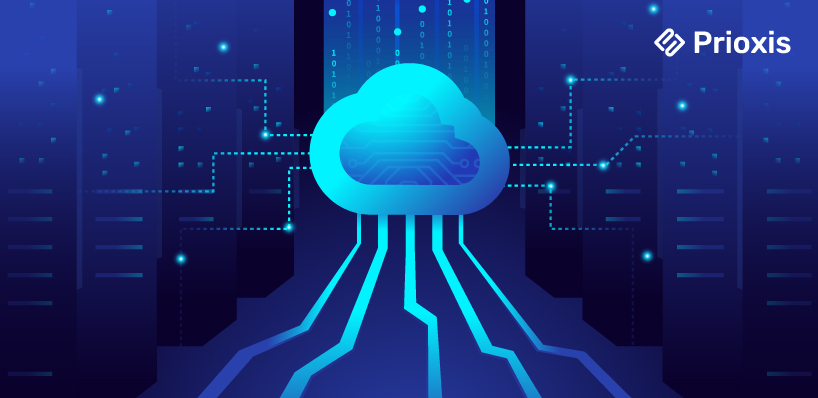
3. Develop and Test
With the architecture and tools in place, start the development process of Cloud Native application development:
a) Write code following Cloud Native principles (12-factor app) for scalability
b) Implement DevOps practices (version control, automated testing) for faster iterations
c) Apply test-driven development and comprehensive testing for quality
4. Deploy and Monitor
As you prepare to deploy the cloud native development services, take advantage of cloud capabilities:
a) Automate deployments through the CI/CD pipelines
b) Use deployment strategies (blue/green, canary) for controlled releases
c) Monitor app performance, logs, and metrics and set up alerts
Benefits of Cloud Native Applications for Businesses
1. Enables Faster Innovation
Due to the DevOps principle, developers can add new features and deploy applications faster without affecting the existing operations. Plus, the loosely coupled microservices allow your team to up individual services much faster than the traditional monolithic application.
2. Less Risk, More Reliable
As your developers can rapidly build and deploy new updates in the cloud native development services, the risk of running your application with higher downtime is reduced. Plus, you can rely on it for a better user experience as you can quickly scale applications during peak times.
3. Scale Whenever Needed
Remember the example of Netflix, where the cloud native application development allowed them to scale much faster. Because they shifted from vertically scaled, single-point-of-failure systems, such as relational databases, to horizontally scalable, distributed cloud systems.
This allowed Netflix to scale out the needed microservices seamlessly and quickly. Thus, with Cloud Native application development, you can balance load based on demand, allowing you to optimize cost and eliminate downtime.
4. Return on Investment
Shifting to cloud native development services may appear expensive, but listening to Netflix's experience after their shift may change your mind. They said, “ Cost reduction was not the main reason we decided to move to the cloud. However, our cloud costs per streaming start ended up being a fraction of those in the data center -- a welcome side benefit.”
They were able to experience this because, with cloud native development services, you spend less on app updates and can take advantage of the elasticity of cloud infrastructure.
5. Better Security
Cloud native development services are more secure due to their inherent design integrating security throughout the application development, delivery, and maintenance processes. Unlike traditional on-premise systems, Cloud Native application development is done with security in tart, allowing for fast detection and resolution of threats.
6. Be More Adaptable
When you plan to make an application available on mobile you need to rework the front and back end. However, with cloud native development services, you only need to build the front end and can use APIs to access data from the server without any back-end code modification. The loose coupling microservices help change one application component without breaking the entire Cloud Native application development.
Challenges
1. Dependency
Cloud Native applications are deployed to different cloud infrastructures using different cloud service models and complex infrastructure as code. This increases dependency and the chances of being affected by the lifecycle of cloud services. Also, sometimes, the company may not be as careful with your data as you are.
2. Complexity
Due to the complex nature of cloud native application development, your team may find it challenging to develop, deploy and manage them. Thus, extensive training and experience may be required.
Wrapping Up
This was all about cloud-native application development and things to know before you get started with it. Today, companies like Netflix, Uber, Airbnb, etc., are utilizing the benefits of cloud-native development services.
With more and more companies using cloud native development services, it is okay to say they can solve modern development challenges. However, migrating to the cloud to improve operational efficiency has several challenges. It may also be difficult if you lack the skilled developers to shift.
At Prioxis, we have a team of experienced cloud application developers who have worked with various businesses. Our developers are well-versed in all public, private, and hybrid cloud environments and can help you smoothly transition to cloud-native application catered to various businesses.
Get in touch
Latest Posts
01What tools and technologies are essential for building cloud native development services?
Tools like Kubernetes, Docker, Prometheus, and Istio are commonly used for Cloud Native application development. Understanding these tools and how they work together is crucial for successful Cloud Native application development.
02What is the difference between cloud native development services and cloud-ready applications?
Cloud native applications are built from the ground to run on the cloud and take advantage of cloud capabilities. In contrast, cloud-ready applications are designed to run on a cloud computing platform without changing the source code.
03Does my business need to go for a Cloud Native application service?
It depends. Evaluate your business needs, cost-benefit analysis, application type, infrastructure compatibility, and expertise to decide if Cloud Native Application Development suits your organisation.
04What is the cost of Cloud Native Application Development?
It will vary depending on many factors, but your existing systems will mainly influence it. The migration costs will be higher if you migrate from legacy systems to cloud applications but lower if you migrate from cloud to cloud.




